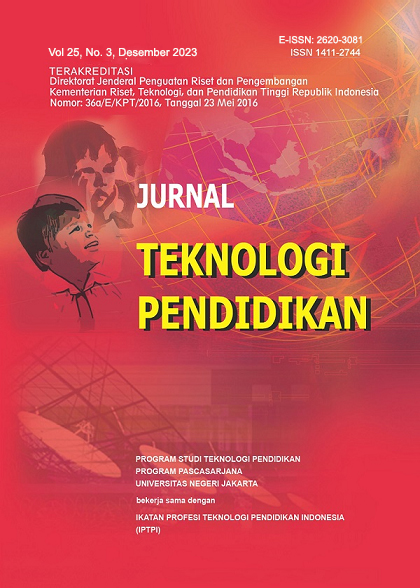Development of Audio-Visual Media on the Physical Motor Development of Students in Big Kindergarten
DOI:
https://doi.org/10.21009/jtp.v25i3.36947Keywords:
Audio Visual Media, Physical Motor, KindergardenAbstract
This study aims to determine the effect of the development of audio-visual media on the motor-physical development of students in BIG Kindergarten. This study involved early childhood students aged 5-6 years as participants. An audio-visual-based online learning approach was used in this study to introduce students to interesting physical activities and support the development of their motor skills. This research method use appropriate methods. The proposed solution is the use of audio-visual media which contains games as access to learning materials to develop children's gross motor skills. LCD/Projector is used to display learning videos. The results showed that the audio-visual media developed, including jumping over shapes, hot ball cold ball, cloth rolling ball, light ball, stepping on a tiger's tail, kangaroo ball game, and motion exercises and songs, had a positive influence on students' physical-motor development. Assessments from physical education experts, sports experts, and teachers show that this media gets a high score in the very good category. Based on the results of this study, it can be concluded that the development of audio-visual media in learning gross motor skills has a positive impact on the physical-motor development of early-age students. This media also received a positive response from students and educators, indicating a higher level of motivation and involvement in sports learning. This research contributes to the development of an innovative and effective learning approach in improving gross motor skills of early childhood students.
References
Burton, A. W., & Miller, D. E. (1998). Movement skill assessment. Human Kinetics.
Clark, J. E., & Metcalfe, J. S. (2002). The mountain of motor development: A metaphor. Motor Development: Research and Reviews, 2(163–190), 183–202.
Gabbard, C. (2021). Lifelong motor development. Lippincott Williams & Wilkins.
Gallahue, D. L., & Ozmun, J. C. (2006). Understanding motor development: Infants, children, adolescents, adults. (No Title).
Goodway, J. D., Ozmun, J. C., & Gallahue, D. L. (2019). Understanding motor development: Infants, children, adolescents, adults. Jones & Bartlett Learning.
Haywood, K. M., & Getchell, N. (2021). Life span motor development. Human kinetics.
Magill, R., & Anderson, D. I. (2010). Motor learning and control. McGraw-Hill Publishing New York.
Muslim, S., Arum, A. P., & Fajarianto, O. (2022). Development of Information and Communication Technology Learning Media. JTP-Jurnal Teknologi Pendidikan, 24(3), 381–388.
Payne, V. G., & Isaacs, L. D. (2017). Human motor development: A lifespan approach. Routledge.
Piek, J. P., Dawson, L., Smith, L. M., & Gasson, N. (2008). The role of early fine and gross motor development on later motor and cognitive ability. Human Movement Science, 27(5), 668–681.
Robinson, L. E., Stodden, D. F., Barnett, L. M., Lopes, V. P., Logan, S. W., Rodrigues, L. P., & D’Hondt, E. (2015). Motor competence and its effect on positive developmental trajectories of health. Sports Medicine, 45, 1273–1284.
Tisnawati, N. F., & Purbaningrum, E. (2022). Braille Innovation Technology in Teaching and Learning Process For Visual Impairment. JTP-Jurnal Teknologi Pendidikan, 24(2), 224–235.
Ulrich, D. A., & Sanford, C. B. (1985). Test of gross motor development. Pro-ed Austin, TX.
Webster, E. K., Martin, C. K., & Staiano, A. E. (2019). Fundamental motor skills, screen-time, and physical activity in preschoolers. Journal of Sport and Health Science, 8(2), 114–121.
Downloads
Published
How to Cite
Issue
Section
License
Jurnal Teknologi Pendidikan is an Open Access Journal. The authors who publish the manuscript in Jurnal Teknologi Pendidikan agree to the following terms.
Attribution-ShareAlike 4.0 International (CC BY-SA 4.0)
-
Attribution — You must give appropriate credit, provide a link to the license, and indicate if changes were made. You may do so in any reasonable manner, but not in any way that suggests the licensor endorses you or your use.
-
ShareAlike — If you remix, transform, or build upon the material, you must distribute your contributions under the same license as the original.
- No additional restrictions — You may not apply legal terms or technological measures that legally restrict others from doing anything the license permits.
Notices:
- You do not have to comply with the license for elements of the material in the public domain or where your use is permitted by an applicable exception or limitation.
- No warranties are given. The license may not give you all of the permissions necessary for your intended use. For example, other rights such as publicity, privacy, or moral rights may limit how you use the material.








